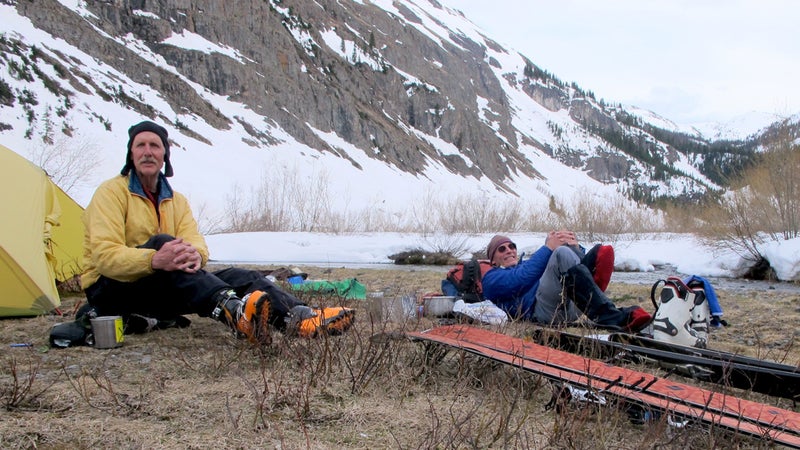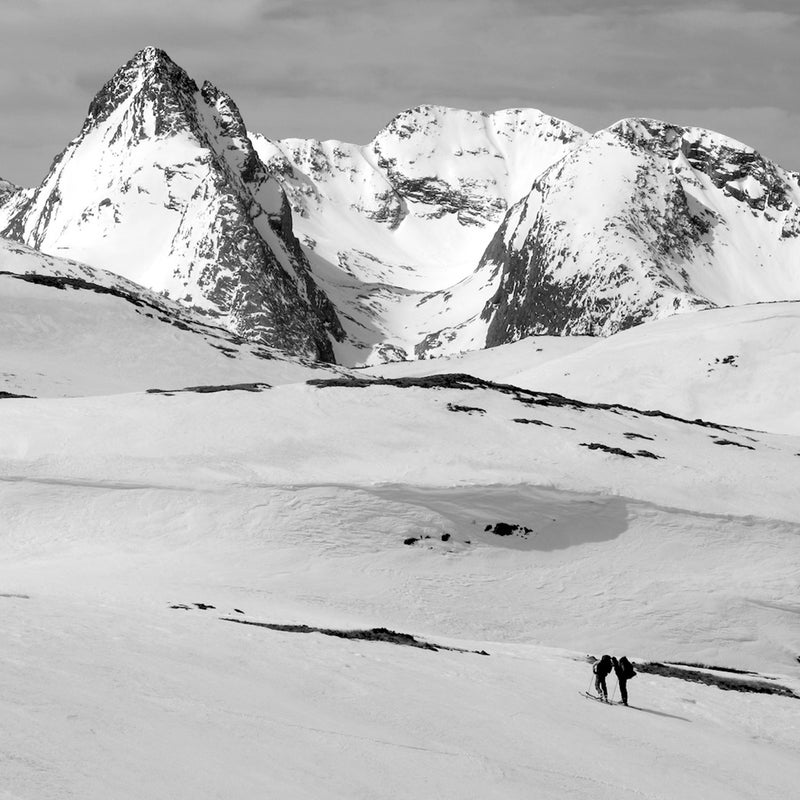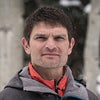Chasing a Couple of Geezers on a San Juan Traverse
Matt Wells and Denny Hogan have been adventuring together for decades. As they push 70, they're not ready to give it up yet.
New perk: Easily find new routes and hidden gems, upcoming running events, and more near you. Your weekly Local Running Newsletter has everything you need to lace up! .
Matt Wells has many nicknames, chief among them Uncle Fuzz, but it isn’t until his old buddy Jerry Roberts calls him abuelo that reality sinks in. We are standing in Roberts’ yard on Easter Sunday 2017, in the small southern Colorado town of Ridgway, inventorying our gear before attempting a ski traverse of the San Juan Range. For some reason, up until now I have viewed this trip like any other. Only when Roberts used the Spanish word for grandpa did I remember: I am about to try and cross one of America’s king ranges with a 70-year-old (Wells)—while following his 68-year-old friend Denny Hogan’s lead.
We pad around in the sun, each of us brimming with the nervous excitement that precedes a week in the wild. The San Juans’ tall, striking skyline looms to the south. I have come at the behest of a friend, 42-year-old Tim Cron, who is four years my senior. Cron used to work with Wells in Idaho and saw in the trip a unique opportunity. Not only would we be chasing a rare objective, but we’d also get to learn from a pair of masters in Wells and Hogan.
Hogan, who organized the trip, drove south from his home in Buena Vista and met me on Wolf Creek Pass the prior day. We stashed a truck there and continued on to Ridgway, where in recent years an impressive array of mountain men have retired to an alpine-desert version of their former selves. Roberts, who used to oversee avalanche mitigation along the notorious between Ouray and Silverton, acts as a sort of ringleader, and whenever a member of the old guard shows up, à la Hogan and Wells, the rest of them emerge like werewolves.
Almost on cue, Peter Lev appears at 10 a.m. A retired guide and former co-owner of in Jackson Hole, Wyoming, Lev partnered with Hogan on an attempted first ascent of the west face of Mount Huntington in Alaska 38 years ago. Earlier this winter, he relocated from the Black Hills to Ouray, just down the road from Ridgway, at the base of Red Mountain Pass. Lev almost summited 13,321-foot Trico Peak yesterday, he tells us, and enjoyed a marvelous solo ski descent. He is 77.
Roberts knows that Cron and I are here to learn from Hogan and Wells, and he assures us we will. “These guys are mentors without being mentors,” he says. “You see how things are done just by watching them.”

Hogan became interested in a San Juans traverse after reading that George Lowe and two friends skied it in 1992. Hogan has since tried it nine times, succeeding four. The 65-mile route basically follows the Continental Divide from west to east, and you spend much of your time above treeline—for better or worse. Hogan had long tried to convince Wells to join him, but it didn’t come together until this year. Wells recruited Cron, his former mentee on the Sun Valley Ski Patrol, and Cron invited me for an even number.
Aiming to complete the traverse in six days—an ambitious timeline even with good conditions—we divvy up supplies in the driveway. Lev, who has climbed the Grand Teton more than 400 times, shakes his index finger at Hogan. “You clearly still like to carry a heavy pack. What the heck is wrong with you?” Hogan laughs and blushes, but weight will indeed prove to be a factor during our trip.
Neither Lev, whose ski pack now consists of a hip pouch with a small bottle of schnapps, nor Roberts can physically handle such a traverse anymore. With each lament that another of their brethren has succumbed to a heart attack or brain tumor, it becomes clear how rare our two partners are. Cron and I are here to see how they still do it, so that one day we can be the holdouts.
Hogan and Wells met as guides in the 1970s while ski training on Teton Pass with, among others, future Patagonia founder Yvon Chouinard. They slept outside 16 days a month and went on to travel together for decades. Wells, who lives in Hailey, Idaho, and still maintains a solid build to go with his fur (hence the “Uncle Fuzz” moniker, or Fuzz for short), spent 14 years guiding on horseback in Mongolia. He also made nine trips to Nepal and 15 to Peru, mostly to climb. Still, he never took himself too seriously, as evidenced by one of his favorite lines during our trip: “Do you know who I was?”
Hogan, whom Roberts likens to a mountain elf, stands five-foot-six and is known from Alaska to Colorado for his modesty and dirtbag ways. He learned to climb when he was 14 and eventually compiled one of the most underrated résumés of any amateur adventurer. In 1974, Hogan and three friends completed the first ski crossing of Greenland’s South Cumberland Peninsula, a journey that took 42 days. “The Inuit thought we were nuts,” Hogan recalls. He has kayaked or rafted the Grand Canyon five times, narrowly survived a speed descent through the Black Canyon of the Gunnison River, made first alpine ascents in remote locations, rock-climbed with the late Fred Beckey, and last year rode his bike from Banff to Buena Vista for fun.
Lev almost summited 13,321-foot Trico Peak yesterday, he tells us, and enjoyed a marvelous solo ski descent. He is 77.
The first time Hogan skied across the San Juans, he did it with the late Randy Udall. They met at Wolf Creek Pass, where Hogan found out Udall only had five days until he was due back home, instead of the seven they’d planned. Hogan, an aerobically gifted athlete who loves to suffer, barely hung on to Udall’s ferocious pace. When they collapsed into camp each night, Udall would swallow a stick of butter and go to sleep, Hogan says. Still, they finished the route, and Hogan was hooked. No one has done it more than he has—or survived more close calls along the way.
As Easter Sunday fades toward dusk, Roberts drops us off at the end of a dirt road in Cunningham Gulch, just outside Silverton. The mid-April snowpack is firm as we set out on skins, crossing under a series of avalanche paths, one of which killed six miners on St. Patrick’s Day in 1906. The valley floor is littered with avalanche debris now, too, 20 feet of snow and broken trees piled up in mounds. We find a dry patch of tundra next to the creek and set up camp. I recline in a mesh-and-aluminum chair, one of a handful of luxuries I have packed. “You’re breaking my heart,” Wells jokes, lying on the ground, chairless.
On our way to Highland Mary Lake the next morning, we stop next to a creek to fill our water bottles. Wells is already struggling to keep pace and acknowledges out loud, for the first time of many, that he is the slowest skier in the group. Not that it dampens his spirit. He looks at Hogan, who has removed his hat for a moment, revealing a horseshoe of hair and a shiny cranium. “Man, you are bald,” Wells says. “You look like an egg in the nest.”
A short time later, we stop again and Hogan asks Wells if he is feeling the altitude—an indirect way of asking why he is moving slower than the rest of us. Wells takes exception. “I remember when you were feeling the altitude,” he fires back. Hogan grins: “Where was that, South America?”
We reach the lake at 4 p.m., and I ditch my pack to ski a run above our camp. Wells shows Cron how to anchor our tent stakes more securely, and I get a lesson in extracting water from a frozen lake courtesy of Hogan, who once trained Navy SEALs in winter survival on Mount Elbert, the highest peak in Colorado. (He also worked as a prison guard and, later, as a bureaucrat with the BLM.)
Hogan, an early proponent of light-and-fast travel, would prefer to bivvy in the open, as he did on most of his 13 trips to Alaska. But he and Wells are sharing a thin shelter here, albeit one that leaves them exposed to wind and snow along the edges. Hogan’s only insulation from the frozen ground is a thin foam pad that extends to his knees. Cron and I, meanwhile, have inflatable pads and a three-season tent with a vestibule.
I am already a little worried about our pace, given we fell short of Hogan’s stated goal this morning. But I remind myself it’s early.
The next morning, Wells and I skin past a set of bear tracks as he tells me about his last big climb, eight years ago in the Cordillera Huayhuash of Peru. He and his partner were 62. “We knew when we got to the top,” Wells says. “We were like, ‘This is it.’”
Later, he shares some life advice out of the blue. “Don’t be afraid to apologize.” I admit that I have a tendency to hold grudges if I feel someone is in the wrong. “You’ll learn to let go,” Wells says.

The four of us stop on a dry tuft of grass at noon, staring across at the Grenadiers subrange, one of the most stunning landscapes in Colorado. Hogan and Wells spent much of their early twenties exploring these peaks with Outward Bound. Forty-five years later, they are content to gape and remember. “That range really excited us as young men,” Wells says. “It was a great place to gain your maturity and do some shit.”
Hogan made the first winter ascent of Jagged Mountain in 1971 with a friend, Arturismo Agasuma, who died two weeks later while climbing the Wham Ridge, which we are looking at as Hogan tells the story. Hogan then points toward Arrow Peak. “See that ramp coming off the north face? I skied that,” he says sheepishly. “It’s my only extreme ski descent.” He pauses, examining the ramp, which turns left above a giant cliff and weaves its way down to an apron. “I’m actually quite proud of it.” He pauses again. “Don’t tell anyone.”
Hogan laments that he can no longer find partners for even moderately hard outings. His neighbor in Buena Vista, 73-year-old ultrarunner John Nail, is an exception. It was Nail who invited Hogan to pedal home from Banff last year. “I asked him, and his wife has asked him the same thing, ‘When are you going to quit?’” Hogan says. “His reply is, ‘When I die. Because if I quit, I’m gonna �徱��.’�ĝ
Both Wells and Hogan have small pensions and collect Social Security. They implore me and Cron not to follow their retirement strategies. Cron, who owns a hotel and bakery in the 100-person town of Stanley, Idaho, isn’t sold. “It depends on what you want to retire to,” he says. “If you want to retire to this, it’s a lot easier than if you want to retire to golfing.”
“Fuck golfing,” Wells snaps.
We lie on our packs in the sun, relishing the moment. I can’t take my eyes off the Grenadiers. It feels like we can touch them. Finally, Hogan and Cron rise and set off once more. Wells dons his pack and steels himself for another long stretch of white expanse toward Hunchback Pass. Just before he leaves, he says to me, “All my life, I’ve done this stuff. Sometimes when I’m out here plodding, I think, Why?” Then he skis off, not bothering to answer.
A half-mile before the pass, Wells runs out of gas. Cron, who is still built like the college football player he was, skins back and takes his friend’s pack. When Wells finally reaches Hunchback, he collapses on the shale. We are already way behind schedule, and it seems imminent that we will pull the plug given further progress could put us in no-man’s land with little food or fuel. But that is Hogan’s decision to make since he knows the route, and he is not ready to concede.
Cron and I climb and ski Hunchback Peak, leaving tracks that shine in the alpenglow from camp. That night, a furious windstorm rolls through. Camped above treeline on an exposed ridge, we get smacked in the face all night by our tent. A pole nearly snaps. It is enough to seal the deal.
Hogan holds an impromptu meeting in their shelter first thing in the morning, where he announces that we are abandoning the traverse. Instead, he suggests we ski down Bear Creek then up to Stony Pass, turning the trip into a loop and ending back at Cunningham Gulch. I try to hide my disappointment.
“Life is story, man,” Wells says on our final climb of the trip. We are nearing Stony Pass, where we will rip our skins and descend all the way to Cunningham Gulch. He is smiling wider than he has all trip. “Man, it’s fun, shooting the breeze.”
We ski down to the Rio Grande River and ford it in our boot shells. Sitting on a grassy bank while our feet dry, Hogan recounts some of his other failures on this route. One year he got caught in a 36-hour blizzard with nothing but a bivvy and shovel. He bailed down Deep Creek, finally taking shelter in an outhouse on the second day, then skied 16 miles to a highway and hitchhiked to Creede. It makes me feel better somehow, knowing he has failed on this route more than he’s succeeded.
We set camp a mile below Stony Pass and make our first fire of the trip, which acts as a salve for my wounded optimism. The flames warm my face as Wells laments the death of amateur alpinism—regular people doing big stuff in king ranges. Neither he nor Hogan has ever been sponsored. “We were just the debris,” Hogan says. By the time I slip into my sleeping bag, I am no longer upset that we bailed. I’m just glad to be debris.
We know it’s cold the next morning because Hogan finally has put on long underwear. Single-digit temperatures, biting wind, and two inches of snow keep us curled up until 9 a.m. Then we set out for our first group ski. We pass a site in the snow where an eagle killed a fox, leaving just the skinned head and some feathers, one of which Hogan collects to bring home.
While climbing a col to a small peak just west of Stony Pass, Wells loses purchase on firm snow and falls, hard. He had been skinning with one climbing bar up and one down to make it easier on his two replaced hips and to compensate for his shortened stride. I feel bad when I see him slide. I downclimb, grab his skis, and help him to his feet. Then we regain the col. We don’t talk much about his slip, but I can tell it’s on his mind.
During the descent, he falls again. As he sidesteps back up to retrieve a pole, I wonder to myself if his end is nigh. But he rebounds once more and finishes his run, then heads back to camp happy to have skied in such a special place.
The next morning, we set out on our final climb of the trip. “Life is story, man,” Wells says. We are nearing Stony Pass, where we will rip our skins and descend all the way to Cunningham Gulch. He is smiling wider than he has all trip. “Man, it’s fun, shooting the breeze.”
The sun beats down on our charred lips and rosy noses. “You’ve seen the scope of our lives on this trip,” Wells adds. “We weren’t big players, but we were always in the game. And therein lies my satisfaction.”
I have wondered for much of the week if I am witnessing a last hurrah for Hogan and Wells as adventure partners. I ask Wells if he’ll do another ski tour like this. “Yeah,” he says. Then he thinks about it. “I say that lightly. I’d like to.”
We arc huge turns, trying not to tip under the weight of our packs, down a glorious bowl and back into Cunningham, where the end of the road awaits. Later that afternoon, we attend an outdoor party in Ridgway, the tiny town where legends live.
Peter Lev, who never said much on an expedition, is blabbering away with Hogan in the barbecue line, sipping IPAs in the spring sun. They can barely hear each other due to loud music and bad ears, but they cling to the moment like they clung to the side of Mount Huntington 38 years ago, pinned by a storm and doubting their chances. Steve House, arguably the world’s greatest alpinist and a Ridgway local, walks up with his wife and toddler son to shake Lev’s hand, as well as the rest of ours.
I had questioned my decision to join this trip, giving up Easter with my family and going incommunicado for a week. But this scene reminds me why I came. We share stories from our week with Roberts and Lev, who are eager to hear about the adventure. That we fell short of Wolf Creek Pass is an afterthought. Roberts tells us that the winds when we were camped on Hunchback likely exceeded 75 miles per hour, based on nearby weather stations.
“Well,” says Lev, a sparkle in his eye, “that’s what you get for wanting to climb mountains.”


